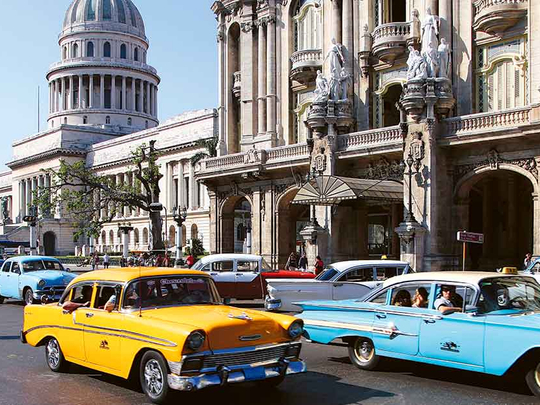
You’ve probably heard it one too many times — go to Cuba now, before it’s too late. Cuba is nothing if not hot property right now. Listed on practically every self-respecting travel expert’s must-visit list for 2015/16, this Caribbean island is undoubtedly on the cusp of change — and worth making the (nearly day long) journey for, sooner rather than later.
While the change is definitely welcomed by the people – I gathered this from speaking to many locals – and will help iron out a lot of the creases that years of poverty and isolation has left the nation with, what it will likely bring with it is also a whitewash of modernisation and cookie-cutter-dom. While I wouldn’t worry too much about the quintessentially Cuban culture being lost to the world – it’s far too strong, rich, and the people too proud to ever let that happen – there is a risk of its quaint, vintage charm disappearing. And soon.
Capital Havana, as the most modern and tourist-friendly of Cuban cities, is probably the best way to experience the authentic local culture. It offers an untarnished version of this vibrant world of colour, perfectly preserved colonial heritage, salsa, Santeria (an Afro-Cuban religion followed by many here), mojitos, and cigars. And yes, it is as exotic and alluring as it looks like in the photos, if not more.
Here is your one-stop guide to Havana essentials:
See and do
Eat and drink
Atmospheric paladars (family-run restaurants where a portion of the home is opened up for diners) are a dime a dozen in Old Havana, but many on the main streets and squares tend to be tourist traps offering overpriced, mediocre meals.
Sometimes, a short walk into a back street will reward you with excellent renditions of modern Cuban cuisine. Ivan Chef Justo is one such restaurant, tucked away above a barber’s salon just across the road from the Revolution Museum.
The small, chef-led restaurant is crammed with an eclectic collection of photographs and bric a brac — think vintage sewing machines — to evoke that homely feel. The tiny kitchen serves up fresh, produce-driven dishes from a daily-changing chalkboard menu.
Equally cosy, but located at the other end of Habana Vieja, near Plaza de la Catedral, is the notoriously hard to get into Dona Eutimia. It offers hearty, home-style Cuban classics such as ropa vieja (a dish of pulled lamb or beef with rice and beans); booking ahead is a must.
For a high-end dining experience — a rarity in Cuba, but the options are increasing — head to La Guarida, a luxury paladar set in a crumbling, still-lived-in mansion. Its claim to fame maybe its starring role in an award-winning Brazilian film, but La Guarida offers good international and modern Cuban fare in intimate and cosy settings.
No visit to Cuba would be complete without paying tribute to its biggest American champion, Ernest Hemingway, and where better than El Floridita? Inventors of the daiquiri, the iconic venue serves up expensive beverages and is worth a visit for the atmosphere and live music performances that are a staple.
Stay
In Cuba, it is standard practice to stay in casa particulars — basically homestays, in which locals can let out spare rooms in their houses.
It is not only an affordable option, but an unparalleled way to interact with locals. But, not all casas are created equal, so it’s important to do your research.
Casa Zaiden is a carefully preserved colonial home, filled with antiques, period furniture, and vintage family memorabilia, that is located in Habana Vieja, within walking distance to all the main attractions, and steps away from the waterfront.
For a slightly more professional, if less personal, experience, Hostal Azul Habana also in Habana Vieja, offers modern, comfortable accommodation in a pared down Cuban setting,
And if you’d rather enjoy the conveniences of a hotel, then Hotel Florida is an elegant, historic property oozing colonial charm, located right in the middle of all the old Havana action.
Getting there
KLM Royal Dutch Airlines offers the most convenient connections to Havana from Dubai via Amsterdam. Visit Klm.com
Need to know
- The closest Cuban embassy is in Saudi Arabia, from where you may need a visa. Contact embacubarabia@nesma.net.sa to find out more.
- The currency in Cuba for tourists is Cuban Convertibe Peso (CUC), similar in value to the US dollar. Another currency, the local peso, is for locals.
- Most casa particulars in Havana are priced at an average of 30CUC (about Dh110) per night, and breakfast — usually fresh fruit, eggs, cheese and bread, with strong Cuban coffee – is an additional 5CUC. Hotel rates start at 80CUC.
- Mains in most restaurants cost between 10-15CUC, but can vary depending on where you dine.







